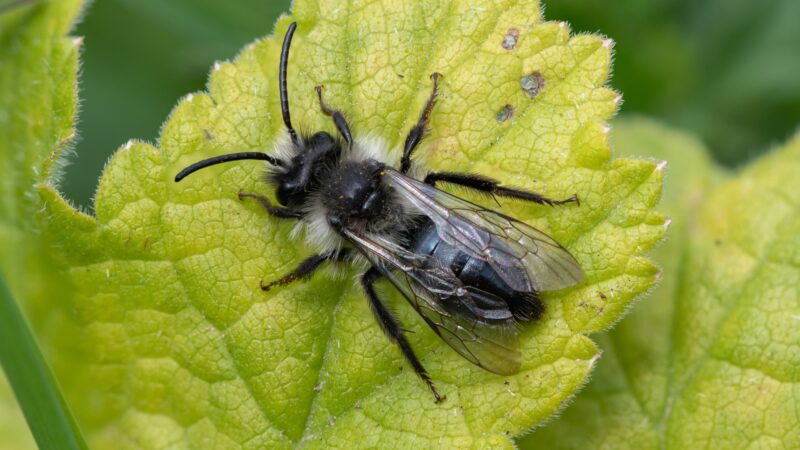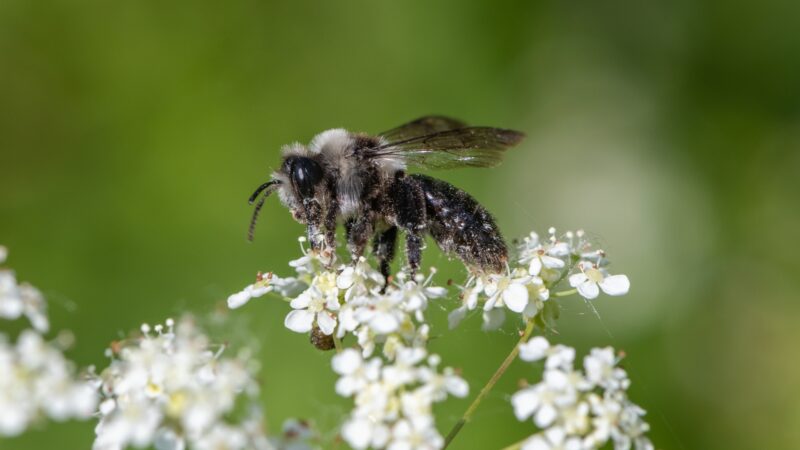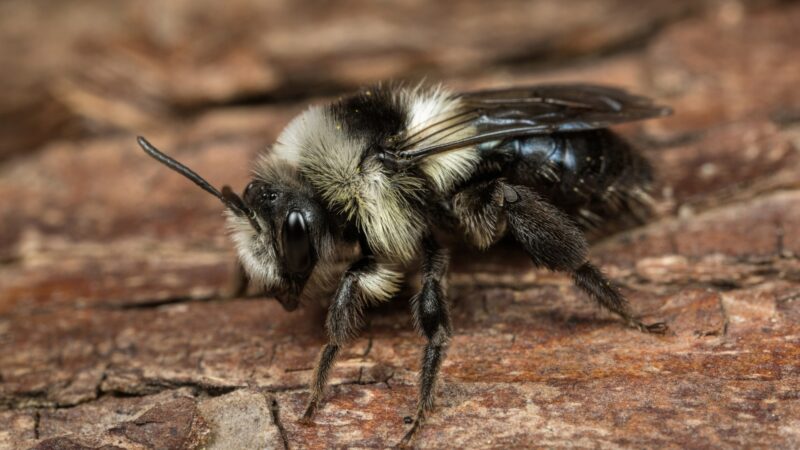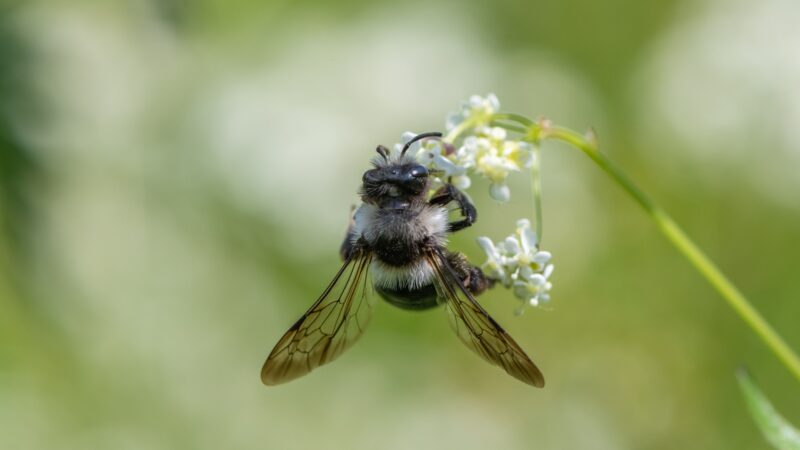Not much is known about the ashy mining bee. Admit it – whenever you think of bees, you instantly think of honey bees and bumble bees.
But the ashy mining bee is equally interesting. And not to mention, it’s also a strong pollinator like its more popular relatives.
The ashy mining bee is a sand bee belonging to the Andrena genus of bees. They’re known for digging tunnels in the sand to serve as their nests. The ashy mining bee has a distinctive black and gray coloration, setting them apart from other bees with yellow and black coloration.
If you want to know more about ashy mining bees, then you came to the right place. This article will serve as your ultimate guide about this lovely bee variety – including how to handle them in case of an infestation.
What Do Ashy Mining Bees Look Like?

The ashy mining bee is notable for its black and gray bristle-like hair covering its entire body – except for the abdomen, which appears glossy. The female ashy mining bee has a similar shape and dimension as a honey bee, but the males are slightly smaller.
They have two sets of compound eyes, a pair of antennas, a pair of transparent wings, and six legs. Because of their adorable fluffy black-and-white appearance, they are fondly likened to flying pandas.
Male and Female Ashy Mining Bees | What’s the Difference?
There are notable differences between male and female ashy mining bees. Females are a few millimeters larger than males. They also have more rounded honeybee-like bodies, while the males are slim-bodied.
While both male and female ashy mining bees have black and white bristle-like hair, only the males are covered all over. The females have a glossy abdomen which is sparsely covered in hair if any. Interestingly, the female abdomen has an iridescent color and gives off a lovely bluish hue when light hits it.
Another known difference is the presence of the stinger. For bees, the stinger forms part of the female reproductive organ. With that said, only female ashy mining bees have stingers.
And if you’re lucky enough to observe them up close, you will notice that the male has 13 segments on its antenna. In contrast, the female ashy mining bee only has 12 segments on its antenna.
To help you visualize the differences, here is a table for your quick reference:
| Male | Female | |
| Size | Smaller and slimmer | Larger and has a curvacious body |
| Hair | Gray and black or white and black bristles covering the entire body; the presence of a white tuft on its head | Hair only covers its head and upper body, while its abdomen is usually hairless |
| Stinger | No stinger | With a stinger |
| Antenna | 13 segments | 12 segments |
| Abdomen | Covered in white and black bristles | Appears glossy and bluish black |
About Ashy Mining Bees

Otherwise known as Gray mining bees or Danubian miners, ashy mining bees are solitary bees that are mostly found in Europe. They’re docile and completely harmless to humans and pets. They are especially noted for digging underground burrows, which serve as their nest for laying eggs and hibernating.
The ashy mining bee’s body is covered in bristle-like hair that collects pollen from the flowers they visit. They also create quite a strong vibration with their wings, and that helps spread pollen to the surrounding flowers. With that said, there’s no doubt that this bee variety is one of nature’s biggest pollinators.
Are Ashy Mining Bees Rare?
Ashy mining bees are not rare. This bee variety is more commonly found in Europe, particularly in the United Kingdom, Ireland, and Scandinavia.
Nevertheless, there are ashy mining bees in the United States, but the fact that they are solitary bees makes them hard to spot.
Are Ashy Mining Bees in the US?
There are ashy mining bees in the United States. However, sightings of the ashy mining bee in the US are quite rare. Honeybees and bumblebees are more common in the United States.
Do Ashy Mining Bees Make Honey?
Ashy mining bees do not make honey. While this bee variety loves collecting nectar from flowers, they use it to feed the larvae. Also, ashy mining bees are solitary, so even if they store the nectar in their hives, it would only be enough to feed their young.
How Long Do Ashy Mining Bees Live?
The ashy mining bee has a life span of around six to eight weeks. On average, female ashy mining bees are known to live longer than males.
Can Ashy Mining Bees Sting?

Female ashy mining bees have stingers that make them capable of stinging. Interestingly, these stingers form part of the female ashy mining bee’s reproductive tract, which is why only the females have them. Nevertheless, they are quite docile and they rarely use their stingers to attack people.
Are Miner Bees Poisonous?
Miner bees are not poisonous. In fact, miner bees are known to be a harmless variety. While they do have stingers, their venom is quite weak to cause any reactions. Also, their stingers are not big enough to create a large puncture on the skin.
Are Ashy Mining Bees Aggressive?

Ashy mining bees are not aggressive. If anything, ashy mining bees are among the most docile bees out there.
As a solitary bee, an ashy mining bee would simply mind its own business – hopping from flower to flower to collect nectar for its young. Given a dangerous situation, ashy mining bees are known to fly away instead of putting up a fight.
How Do You Get Rid of Mining Bees Without Killing Them?
Mining bees are ground dwellers, making them harder to get rid of than bees living in hives. Fortunately, there are ways to surely get rid of mining bees without killing them.
- Sprinkle the sand with cinnamon. Mining bees hate the smell of cinnamon. Once you have determined where they have burrowed in the soil, sprinkle the area with cinnamon powder like the Starwest Botanicals Organic Ceylon Cinnamon Powder . Once the mining bee gets a whiff of the sweet spicy scent of cinnamon, it will surely fly as far away from it as possible.
- Latin/Botanical Name: Cinnamomum verum; Origin:
- Drive them away with citronella. Aside from cinnamon, citronella is another alternative. Ashy mining bees are repulsed by the strong citrus scent of citronella, so spraying citronella oil near their burrow will surely get rid of them – and prevent their return.
- Flush your lawn with water. If you don’t want to sprinkle anything in your garden, the best option is to flush your lawn with water. When the soil becomes muddy, the mining bee will no longer find it habitable. It will then look for another sandy place to burrow a nest.
How Do You Keep Bees From Coming Back?
The best solution to keep these bees off of your property is to prevent them from being attracted in the first place. This doesn’t mean that you shouldn’t plant flowers. However, here are some strategies that you should bear in mind.:
- Plant bee-repulsing plants. When you plant more plants, mining bees will have less sandy soil to burrow. But more importantly, if you choose to plant those that mining bees are naturally repulsed by, then they won’t even bother to go near your home. Some of these plants include lavender, peppermint, and citronella.
- Sprinkle the garden with cinnamon powder from time to time. By doing so, your garden will start to smell like cinnamon. Particularly, the sand will have that sweet-spicy scent that bees fly away from. With that said, bees are sure to fly by your garden without considering it as a potential host for its nest.
- Add more rocks or bricks to your garden. Mining bees create nests by digging through the sand. If they are unable to make their burrows, then expect them to look for another location. You can do so by blocking their access to sand by using rocks or bricks.
Why Do Ashy Mining Bees Bury Themselves in Soil?
There are only two reasons why ashy mining bees bury themselves in soil: for laying their eggs and to prepare for hibernation.
Female ashy mining bees are known to make burrows in sandy soil to serve as their nest. In a few days after burrowing, it will lay its eggs, and the young larvae will spend most of their time in these burrows.
Nevertheless, all ashy mining bees seek shelter in these nests during the harsh winter. They hibernate for the rest of the cold season and only emerge once it’s springtime.
Good Lawn Care Practices to Avoid Ashy Mining Bees
Plant and maintain a thick turf. When your lawn has thick vegetation, ashy mining bees do not have enough space to make their nest. However, make sure that this thick turf is well maintained to keep other pests away.
Add landscaping. Another good lawn care practice that you should observe is good landscaping. As previously mentioned, blocking the bees’ access to sandy soil will make it impossible for them to build a nest.
By incorporating bricks, rocks, and other landscaping elements into your lawn, you’re already preventing their presence in your lawn. But most importantly, make sure to check these bricks and rocks regularly since erosion can occur, and that leaves spaces for the mining bees to crawl under.
Water your lawn regularly. Ashy mining bees prefer to dig sandy soil – as opposed to mushy, moist soil. With that said, watering your lawn regularly will prevent them from thinking that your lawn is an ideal spot for their nest.
List of Sources
Dar, S. A., et al. (2021). Nesting behaviour and foraging characteristics of Andrena cineraria (Hymenoptera: Andrenidae). National Library of Medicine.
Russell, H. (2017). Solitary bees in yards a temporary nuisance. Michigan State University.
Rourke, K. Miner Bee (Anthophora abrupta). United States Department of Agriculture.
- How to Get Rid of Copperheads | Practical Guide - August 27, 2023
- How to Get Rid of Corn Snakes | What Makes Them Aggressive? - August 27, 2023
- How to Get Rid of Alligators | Safety Measures and Removal Methods - July 16, 2023

